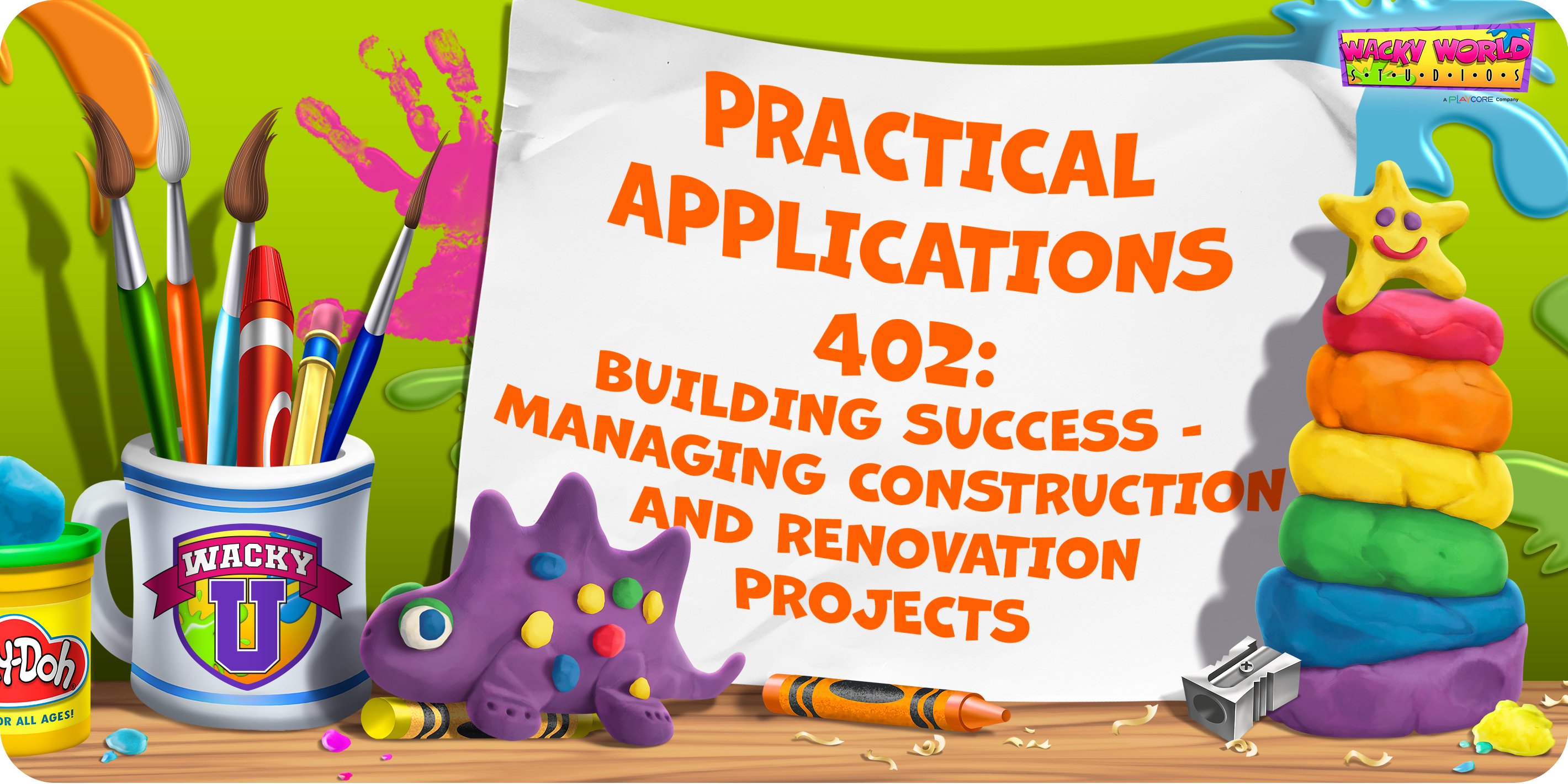Churches & Religious Organizations, Healthcare, Early Education, Parks & Rec, Practical Applications
A Guide to Successful Construction and Renovation Projects
September 10, 2024
Starting a construction or renovation project is an exciting opportunity to grow your organization, whether it’s a pediatric healthcare facility, a church expanding its ministry, a parks & rec center upgrading its facilities, or an early education center expanding classrooms. However, the complexity of these projects can be overwhelming.
From budgeting to partnering with the right team, successful project management is critical to ensure the project stays on track, meets its goals, and serves the needs of the community. This course dives into key strategies that will help you manage your project efficiently and effectively, with a special focus on areas serving children and families.
Course Syllabus
Laying the Foundation: Crafting a Budget That Works- How to Build a Practical Budget
- Crafting a Realistic Timeline
Securing the Green Light: Fundraising and Financial Readiness
- How to Secure the Right Funding
- Avoiding Funding Pitfalls
Building the Dream Team: Selecting the Right Experts
- How to Build the Right Team
- Fostering Strong Communication
Managing Risks and Changes
- How to Anticipate and Mitigate Risks
- Handling Change Orders
Monitoring Progress and Staying Flexible
- How to Track and Manage Progress
Bringing Your Vision to Life: Turning Blueprints into Lasting Impact
Final Exam
Laying the Foundation: Crafting a Budget That Works
A solid budget is the bedrock of any successful construction project, but getting it right requires thorough planning and a flexible approach. While it’s impossible to predict every expense, there are steps you can take to ensure your budget holds up under pressure.
How to Build a Practical Budget
-
Conduct Thorough Research Early On: Before setting your budget, collaborate with experts—architects, contractors, and consultants. Their early involvement provides clarity on potential costs, from basic construction materials to industry-specific expenses. For example, pediatric healthcare projects may need specialized medical equipment or compliance with health regulations, while parks & rec projects may require specific outdoor safety measures or landscaping.
-
Itemize Costs and Include a Buffer: Break down your budget into labor, materials, permits, and contingency funds. A contingency buffer of 10-20% is essential for absorbing unexpected costs, such as supply delays or regulatory issues that could arise in any sector, from early education to healthcare.
-
Review Historical Data: If your organization has previously managed construction projects, look at past budgets to identify areas where costs were underestimated or where savings could have been made. This is especially important for large-scale projects like church expansions, where specific design features—such as themed children’s areas—may have exceeded initial projections.
Crafting a Realistic Timeline
-
Set Phases and Milestones: Break the project into clear phases (e.g., design, permitting, construction) and set milestones for each phase. For example, in a pediatric healthcare facility, you might mark completion of the foundation, electrical systems, and compliance inspections as key milestones.
-
Account for Delays: Always build extra time into your schedule to account for potential delays. This is particularly relevant for projects in parks & rec where weather conditions can significantly slow outdoor work, or early education centers that need to navigate local inspection timelines.
-
Collaborate with Stakeholders Early: From the outset, get input from everyone involved, whether it’s community members for parks & rec projects or medical professionals for healthcare facilities. This ensures that the timeline reflects realistic expectations and avoids disruptions later on.
Securing the Green Light: Fundraising and Financial Readiness
Jumping into construction without having all necessary funding in place can lead to delays, cost overruns, or even project failure. Securing full financing from the start ensures a smoother process and guarantees your vision can become a reality.
How to Secure the Right Funding
-
Diversify Funding Sources: Don’t rely solely on one funding source. Churches often run capital campaigns alongside traditional loans, while early education centers may seek grants or community donations. Pediatric healthcare facilities may benefit from a mix of government grants, private donations, or public-private partnerships.
-
Develop a Financial Plan: This should cover all expenses, including construction, materials, and post-project maintenance. Detail where each dollar will come from, whether it's from fundraising efforts, loans, or grant funding.
-
Align Financing with the Timeline: Ensure that your funding matches your construction schedule. For example, if you're relying on phased grants or donations, be sure that these funds are available when needed to avoid interrupting the work.
Avoiding Funding Pitfalls
-
Ensure Stakeholder Buy-In: Whether it's a board of directors, a congregation, or a city council, gaining early financial approval from all stakeholders reduces the likelihood of mid-project funding gaps. This is especially important for parks & rec projects that often depend on municipal budgets or public contributions.
-
Plan for Long-Term Operational Costs: It's not just about construction costs—also consider the long-term operational expenses of maintaining the new space. For example, in healthcare, future staffing and technology costs must be accounted for early, while a parks & rec center might need funding for ongoing maintenance of playground equipment or green spaces.
PlayCore's Grant Finder Tool
Find a Funding Partner
A recent study estimates $360 billion is available for community play and recreation projects worldwide. PlayCore’s Grant Finder Tool compiles hundreds of local, regional, national, and global funding sources, complete with contact details, websites, grants, and deadlines, making it an essential fundraising resource.

Building the Dream Team: Selecting the Right Experts
Choosing the right team is essential for the successful completion of your project. From contractors to architects to industry-specific consultants, you’ll need a group of experts that can bring your vision to life and stay aligned with your goals.
How to Build the Right Team
-
Hire Industry-Specific Experts: Ensure your team has experience in your industry. For example, pediatric healthcare requires architects and contractors who understand the stringent requirements for patient safety and infection control. Similarly, if you’re working on an early education facility, seek out architects who specialize in creating child-friendly and sensory-rich environments.
-
Request References and View Past Work: Vet each team member thoroughly. Visit their previous work sites to get a feel for their style, efficiency, and the quality of their work. Contractors for parks & rec projects, for instance, should have experience designing spaces that are both functional and durable in outdoor settings.
-
Consider a Project Manager: A dedicated project manager can keep your project on track. They will ensure tasks are completed on time, manage day-to-day issues, and serve as a liaison between contractors, architects, and stakeholders. This is especially helpful when managing multi-faceted projects like a large church expansion that involves numerous specialty areas such as worship spaces, youth rooms, and play areas.
Fostering Strong Communication
-
Establish Regular Check-ins: Set up regular meetings with your team to assess progress, address issues, and ensure alignment. Weekly meetings with contractors, architects, and stakeholders can prevent small problems from growing into major delays.
-
Centralize Documentation and Communication: Use project management tools to keep everyone informed. Whether it’s sharing the latest architectural blueprints or scheduling inspections, a centralized system ensures no one is left out of the loop.
-
Be Transparent with Stakeholders: Keep all stakeholders, including community members, congregants, or board members, informed with regular progress updates. In church projects, for instance, this transparency fosters trust and support, especially if donations are helping to fund the project.
Managing Risks and Changes
Construction projects are full of surprises—unexpected weather, material shortages, or even regulatory changes can disrupt the process. Being proactive in managing these risks is essential to keeping your project on track.
How to Anticipate and Mitigate Risks
-
Conduct a Risk Assessment: Before the project begins, identify potential risks and obstacles. For example, in pediatric healthcare projects, you might encounter stricter-than-expected regulatory requirements, while parks & rec projects may face environmental assessments.
-
Create a Contingency Plan: Having a plan for managing unforeseen issues—such as delays in material delivery or inclement weather—is key. Build this into both your budget and timeline. For example, a church renovation might require a temporary worship space if construction overruns its deadline, while a parks & rec project may need alternative vendors for playground equipment.
Handling Change Orders
-
Implement a Clear Change Order Process: Construction projects often require adjustments—whether it’s upgrading materials, changing layouts, or dealing with unexpected structural issues. Establish a formal process for handling change orders, ensuring that each request is reviewed for its impact on cost and timeline.
-
Track the Impact of Changes: Whenever there’s a change to the original plan, assess how it affects the overall budget and timeline. Record all changes and ensure stakeholders are aware of their implications. This is especially important in early education and healthcare projects, where design changes may need to comply with safety or learning standards.
Monitoring Progress and Staying Flexible
Regularly monitoring your project’s progress is essential to ensure that it stays on track. At the same time, staying flexible and adapting to changes as they arise is critical.
How to Track and Manage Progress
-
Set Key Performance Indicators (KPIs): KPIs allow you to measure whether the project is progressing as expected. These could include budget tracking, task completion rates, or the achievement of specific milestones, such as completing the electrical work or obtaining necessary permits.
-
Regular Site Visits: Conduct regular inspections to ensure that the work is being completed to the desired standard. In healthcare and early education projects, this may involve checking that safety regulations are being followed, while in parks & rec, it could be verifying that equipment is being installed according to the agreed plan.
-
Stay Flexible: Even with the best planning, things can change. The ability to pivot and make informed decisions quickly can keep the project moving forward. For example, if material costs rise unexpectedly, consider alternative suppliers or materials that still meet your needs.
Bringing Your Vision to Life: Turning Blueprints into Lasting Impact
Successfully managing a construction or renovation project—whether in pediatric healthcare, churches, parks & recreation, or early education—requires careful planning, strong communication, and a dedicated team. By setting a realistic budget and timeline, securing all necessary funding, partnering with the right team, managing risks, and monitoring progress, you can create a space that serves your community for years to come.
Effective project management ensures that your vision is realized, and the final result meets the needs of the children and families who will use the space.
Ready to test your knowledge?
Stay in the know with Wacky World Studios! We're here to help you with all stages of your theming journey. Make sure you sign up for our monthly newsletter and subscribe to this blog for even more handy theming resources and information. You can also get lots of great inspiration when you follow us on social. Our Pinterest and Instagram pages are overflowing with photos and ideas.
Subscribe here for Wacky U updates!
And for you DIYers, be sure to check out our online shop at WackyWorldDIY.com.


